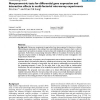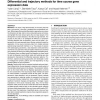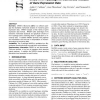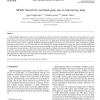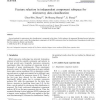BMCBI
2005
14 years 7 months ago
2005
Background: The most common method of identifying groups of functionally related genes in microarray data is to apply a clustering algorithm. However, it is impossible to determin...
BMCBI
2005
14 years 7 months ago
2005
Background: Numerous nonparametric approaches have been proposed in literature to detect differential gene expression in the setting of two user-defined groups. However, there is ...
BMCBI
2005
14 years 7 months ago
2005
Background: Life processes are determined by the organism's genetic profile and multiple environmental variables. However the interaction between these factors is inherently ...
BMCBI
2005
14 years 7 months ago
2005
Background: In the analysis of microarray data one generally produces a vector of p-values that for each gene give the likelihood of obtaining equally strong evidence of change by...
BMCBI
2005
14 years 7 months ago
2005
Background: Microarray devices permit a genome-scale evaluation of gene function. This technology has catalyzed biomedical research and development in recent years. As many import...
BIOINFORMATICS
2005
14 years 7 months ago
2005
Motivation: The issue of high dimensionality in microarray data has been, and remains, a hot topic in statistical and computational analysis. Efficient gene filtering and differen...
BIOINFORMATICS
2005
14 years 7 months ago
2005
Summary: MADE4, microarray ade4, is a software package that facilitates multivariate analysis of microarray gene expression data. MADE4 accepts a wide variety of gene expression d...
KES
2006
Springer
14 years 7 months ago
2006
Springer
In recent years, the rapid development of DNA Microarray technology has made it possible for scientists to monitor the expression level of thousands of genes in a single experiment...
JBI
2008
14 years 7 months ago
2008
Gene Ontology (GO) terms are often used to interpret the results of microarray experiments. The most common approach is to perform Fisher's exact tests to find gene sets anno...
IJON
2006
14 years 7 months ago
2006
A novel method for microarray data classification is proposed in this letter. In this scheme, the sequential floating forward selection (SFFS) technique is used to select the inde...

